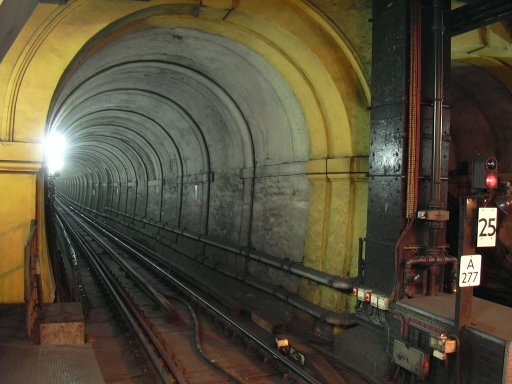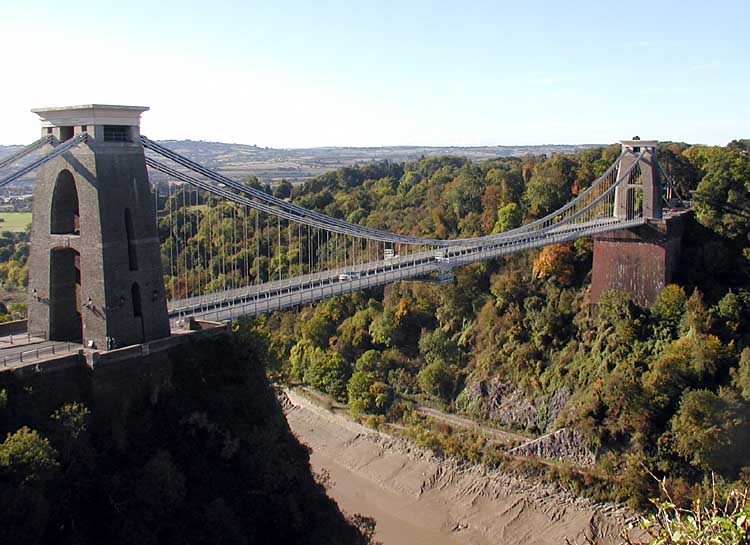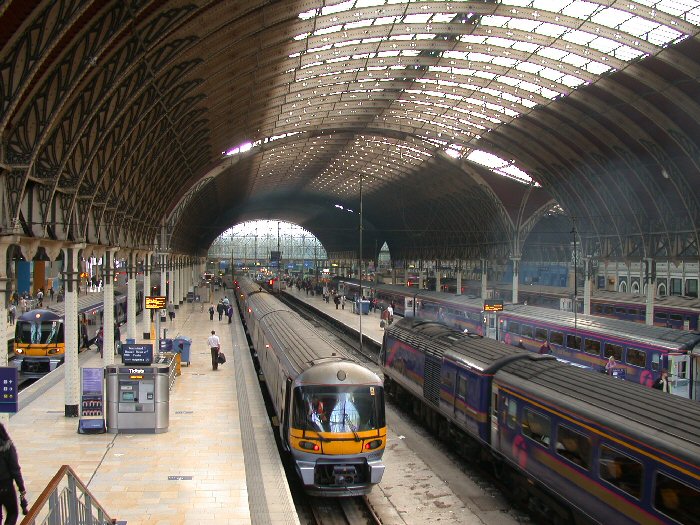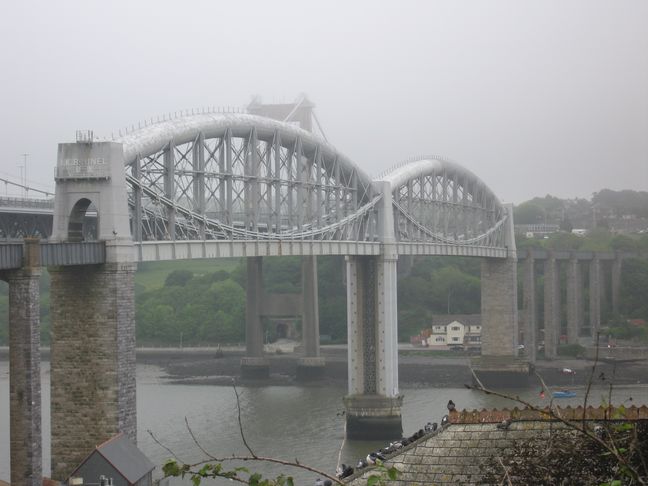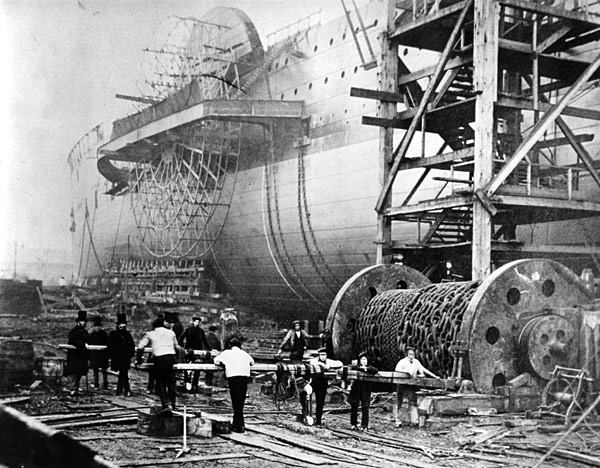<Back to Index>
- Engineer Isambard Kingdom Brunel, 1806
- Composer Johann Kaspar Kerll, 1627
- General der Infanterie Erich Friedrich Wilhelm Ludendorff, 1865
PAGE SPONSOR
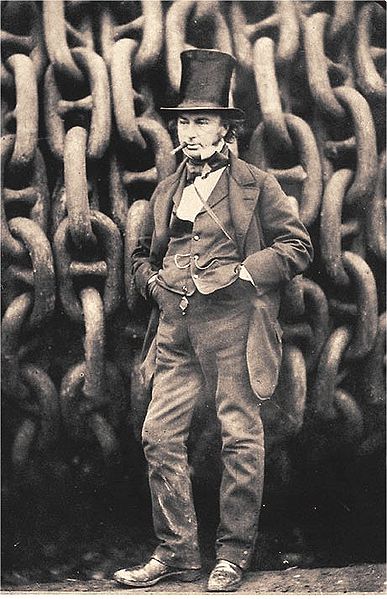
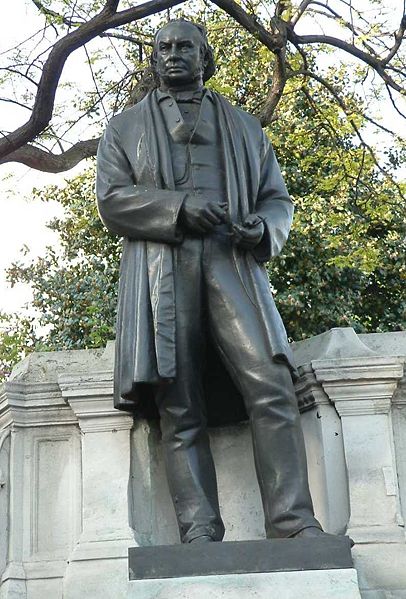
Isambard Kingdom Brunel, FRS (9 April 1806 – 15 September 1859), was a leading Britishcivil engineer, famed for his bridges and dockyards, and especially for the construction of the first major British railway, the Great Western Railway; a series of famous steamships, including the first propeller driven transatlantic steamship; and numerous important bridges and tunnels. His designs revolutionised public transport and modern engineering.
Though Brunel's projects were not always successful, they often contained innovative solutions to long standing engineering problems. During his short career, Brunel achieved many engineering "firsts", including assisting in the building of the first tunnel under a navigable river and development of SS Great Britain, the first propeller driven ocean going iron ship, which was at the time (1843) also the largest ship ever built. Brunel set the standard for a very well built railway, using careful surveys to minimise grades and curves. That necessitated expensive construction techniques and new bridges and viaducts, and the famous two - mile long Box Tunnel. One controversial feature was the wide gauge, a "broad gauge" of 7 ft 0 1⁄4 in (2,140 mm), instead of what was later to be known as 'standard gauge' of 4 ft 8 1⁄2 in (1,435 mm). The wider gauge added to passenger comfort but made construction much more expensive and caused difficulties when eventually it had to interconnect with other railways using the narrower gauge. As a result of the Railway Regulation (Gauge) Act 1846 (and after Brunel's death) the gauge was changed to standard gauge throughout the GWR network. Brunel astonished Britain by proposing to extend the Great Western Railway westward to North America by building steam powered iron hulled ships. He designed and built three ships that revolutionised naval engineering. In 2002, Brunel was placed second in a BBC public poll to determine the "100 Greatest Britons". In 2006, the bicentenary of his birth, a major programme of events celebrated his life and work under the name Brunel 200.
The son of the eminent engineer Sir Marc Isambard Brunel and Sophia Kingdom Brunel, Isambard Kingdom Brunel was born on 9 April 1806 in Portsmouth, Hampshire, where his father was working on block making machinery. He had two older sisters, Sophia and Emma, and the whole family moved to London in 1808 for his father's work. Brunel had a happy childhood, despite the family's constant money worries, with his father acting as his teacher during his early years. His father taught him drawing and observational techniques from the age of four and Brunel had learned Euclidean geometry by eight. During this time he also learned fluent French and the basic principles of engineering. He was encouraged to draw interesting buildings and identify any faults in their structure.
When Brunel was eight he was sent to Dr Morrell's boarding school in Hove, where he learned the classics. His father, a Frenchman by birth, was determined that Brunel should have access to the high quality education he had enjoyed in his youth in France; accordingly, at the age of 14, the younger Brunel was enrolled first at the College of Caen in Normandy, then at Lycée Henri - Quatre in Paris. When Brunel was 15, his father, who had accumulated debts of over £5,000, was sent to a debtors' prison. After three months went by with no prospect of release, Marc let it be known that he was considering an offer from the Tsar of Russia. In August 1821, facing the prospect of losing a prominent engineer, the government relented and issued Marc £5,000 to clear his debts in exchange for his promise to remain in Britain. When Brunel completed his studies at Henri - Quatre in 1822, his father had him presented as a candidate at the renowned engineering school École Polytechnique, but as a foreigner he was deemed ineligible for entry. Brunel subsequently studied under the prominent master clockmaker and horologist Abraham - Louis Breguet, who praised Brunel's potential in letters to his father. In late 1822, having completed his apprenticeship, Brunel returned to England.
Brunel worked for several years as assistant engineer on the project to create a tunnel under London's River Thames, with tunnellers driving a horizontal shaft from one side of the river to the other under the most difficult and dangerous conditions. Brunel's father, Marc, was the chief engineer, and the project was funded by the Thames Tunnel Company.
The composition of the riverbed at Rotherhithe was often little more than waterlogged sediment and loose gravel. An ingenious tunnelling shield designed by Marc Brunel helped protect workers from cave - ins, but two incidents of severe flooding halted work for long periods, killing several workers and badly injuring the younger Brunel. The latter incident, in 1828, killed the two most senior miners, and Brunel himself narrowly escaped death. He was seriously injured, and spent six months recuperating. The event ended work on the tunnel for several years.
Brunel is perhaps best remembered for the Clifton Suspension Bridge in Bristol. Spanning over 700 ft (210 m), and nominally 200 ft (61 m) above the River Avon, it had the longest span of any bridge in the world at the time of construction. Brunel submitted four designs to a committee headed by Thomas Telford, but Telford rejected all entries, proposing his own design instead. Vociferous opposition from the public forced the organising committee to hold a new competition, which was won by Brunel. Afterwards, Brunel wrote to his brother - in - law, the politician Benjamin Hawes: "Of all the wonderful feats I have performed, since I have been in this part of the world, I think yesterday I performed the most wonderful. I produced unanimity among 15 men who were all quarrelling about that most ticklish subject — taste". It has recently been suggested that Brunel did not design the bridge.
Work on the Clifton bridge started in 1831, but was suspended due to the Queen Square riots caused by the arrival of Sir Charles Wetherell in Clifton. The riots drove away investors, leaving no money for the project, and construction ceased. Brunel did not live to see the bridge finished, although his colleagues and admirers at the Institution of Civil Engineers felt it would be a fitting memorial, and started to raise new funds and to amend the design. Work recommenced in 1862 and was completed in 1864, five years after Brunel's death. The Clifton Suspension Bridge still stands, and over 4 million vehicles traverse it every year.
Brunel designed many bridges for his railway projects, including the Royal Albert Bridge spanning the River Tamar at Saltash near Plymouth, an unusual laminated timber framed bridge near Bridgwater, the Windsor Railway Bridge, and the Maidenhead Railway Bridge over the Thames in Berkshire. This last was the flattest, widest brick arch bridge in the world and is still carrying main line trains to the west, even though today's trains are about 10 times as heavy as any Brunel ever imagined.
In 1845 Hungerford Bridge, a suspension footbridge across the Thames near Charing Cross Station in London, was opened. It was replaced by a new railway bridge in 1859, and the suspension chains were used to complete the Clifton Suspension Bridge.
Throughout his railway building career, but particularly on the South Devon and Cornwall Railways where
economy was needed and there were many valleys to cross, Brunel made
extensive use of wood for the construction of substantial viaducts; these have had to be replaced over the years as their primary material, Kyanised Baltic Pine became uneconomical to obtain.
Brunel designed the Royal Albert Bridge in 1855 for the Cornwall Railway, after Parliament rejected his original plan for a train ferry across the Hamoaze — the estuary of the tidal Tamar, Tavy and Lynher. The bridge (of bowstring girder or tied arch construction) consists of two main spans of 455 ft (139 m), 100 ft (30 m) above mean high spring tide, plus 17 much shorter approach spans. Opened by Prince Albert on 2 May 1859, it was completed in the year of Brunel's death.
Several of Brunel's bridges over the Great Western Railway might be demolished because the line is to be electrified, and there is inadequate clearance for overhead wires. Buckinghamshire County Council is negotiating to have further options pursued, in order that all nine of the remaining historic bridges on the line can be saved.
In the early part of Brunel's life, the use of railways began to take off as a major means of transport for goods. This influenced Brunel's involvement in railway engineering, including railway bridge engineering. In 1833, before the Thames Tunnel was complete, Brunel was appointed chief engineer of the Great Western Railway, one of the wonders of Victorian Britain, running from London to Bristol and later Exeter. The company was founded at a public meeting in Bristol in 1833, and was incorporated by Act of Parliament in 1835. It was Brunel's vision that passengers would be able to purchase one ticket at London Paddington and travel from London to New York, changing from the Great Western Railway to the Great Western steamship at the terminus in Neyland, South Wales. He surveyed the entire length of the route between London and Bristol himself.
Brunel made two controversial decisions: to use a broad gauge of 7 ft 0 1⁄4 in (2,140 mm) for the track, which he believed would offer superior running at high speeds; and to take a route that passed north of the Marlborough Downs — an area with no significant towns, though it offered potential connections to Oxford and Gloucester — and then to follow the Thames Valley into London. His decision to use broad gauge for the line was controversial in that almost all British railways to date had used standard gauge. Brunel said that this was nothing more than a carry over from the mine railways that George Stephenson had worked on prior to making the world's first passenger railway. Brunel proved through both calculation and a series of trials that his broader gauge was the optimum size for providing both higher speeds and a stable and comfortable ride to passengers. In addition the wider gauge allowed for larger carriages and thus greater freight capacity.
Drawing on Brunel's experience with the Thames Tunnel, the Great Western contained a series of impressive achievements — soaring viaducts such as the one in Ivybridge, specially designed stations, and vast tunnels including the Box Tunnel, which was the longest railway tunnel in the world at that time. There is an anecdote that the Box Tunnel may have been deliberately oriented so that the rising sun shines all the way through it on Brunel's birthday.
The initial group of locomotives ordered by Brunel and to his own specifications proved unsatisfactory, apart from the North Star locomotive, and 20 year old Daniel Gooch (later Sir Daniel) was appointed as Superintendent of Locomotives. Brunel and Gooch chose to locate their locomotive works at the village of Swindon, at the point where the gradual ascent from London turned into the steeper descent to the Avon valley at Bath.
Brunel's achievements ignited the imagination of the technically minded Britons of the age, and he soon became one of the most famous men in the country on the back of this interest.
After Brunel's death the decision was taken that standard gauge should be used for all railways in the country. Despite the Great Western's claim of proof that its broad gauge was the better (disputed by at least one Brunel historian), the decision was made to use Stephenson's standard gauge, mainly because this had already covered a far greater amount of the country. However, by May 1892 when the broad gauge was abolished the Great Western had already been re-laid as dual gauge (both broad and standard) and so the transition was a relatively painless one. At the original Welsh terminus of the Great Western railway at Neyland, sections of the broad gauge rails are used as handrails at the quayside, and a number of information boards there depict various aspects of Brunel's life. There is also a larger than life bronze statue of him holding a steamship in one hand and a locomotive in the other.
The present London Paddington station was designed by Brunel and opened in 1854. Examples of his designs for smaller stations on the Great Western and associated lines which survive in good condition include Mortimer, Charlbury and Bridgend (all Italianate) and Culham (Tudorbethan). Surviving examples of wooden train sheds in his style are at Frome and Kingswear.
The great achievement that was the Great Western Railway has been immortalised at Swindon Steam Railway Museum.
Overall, there were negative views as to how society viewed the railways. Some landowners felt the railways were a threat to amenities or property values and others requested tunnels on their land so the railway could not be seen.
Though ultimately unsuccessful, another of Brunel's interesting use of technical innovations was the atmospheric railway, the extension of the Great Western Railway (GWR) southward from Exeter towards Plymouth, technically the South Devon Railway (SDR), though supported by the GWR. Instead of using locomotives, the trains were moved by Clegg and Samuda's patented system of atmospheric (vacuum) traction, whereby stationary pumps sucked air from the tunnel.
The section from Exeter to Newton (now Newton Abbot) was completed on this principle, and trains ran at approximately 68 miles per hour (109 km/h). Pumping stations with distinctive square chimneys were sited at two mile intervals. Fifteen inch (381 mm) pipes were used on the level portions, and 22 inch (559 mm) pipes were intended for the steeper gradients.
The technology required the use of leather flaps to seal the vacuum pipes. The natural oils were drawn out of the leather by the vacuum, making the leather vulnerable to water, rotting it and breaking the fibres when it froze. It had to be kept supple with tallow, which is attractive to rats. The flaps were eaten, and vacuum operation lasted less than a year, from 1847 (experimental service began in September; operations from February 1848) to 10 September 1848. It has been suggested that the whole project was an expensive flop. In Brunel's favour, it has been noted that he had the courage to call a halt to the venture instead of struggling on with it at greater cost.
The accounts of the SDR for 1848 suggest that atmospheric traction cost 3s 1d (three shillings and one penny) per mile compared to 1s 4d/mile for conventional steam power. A number of South Devon Railway engine houses still stand, including that at Totnes (scheduled as a grade II listed monument in 2007 to prevent its imminent demolition, even as Brunel's bicentenary celebrations were continuing) and at Starcross, on the estuary of the River Exe, which is a striking landmark, and a reminder of the atmospheric railway, also commemorated as the name of the village pub.
A section of the pipe, without the leather covers, is preserved at the Didcot Railway Centre.
In
1835, before the Great Western Railway had opened, Brunel proposed
extending its transport network by boat from Bristol across the
Atlantic Ocean to
New York. The Great Western Steamship Company was
formed by Thomas Guppy for that purpose. It was widely disputed whether
it would be commercially viable for a ship powered purely by steam to
make such long journeys. Technological developments in the early
1830s — including the invention of the surface condenser, which allowed boilers to run on salt water without stopping to be
cleaned — made longer journeys more possible, but it was generally
thought that a ship would not be able to carry enough fuel for the trip
and have room for a commercial cargo. Brunel formulated the theory that
the amount a ship could carry increased as the cube of its dimensions,
whereas the amount of resistance a ship experienced from the water as
it travelled only increased by a square of its dimensions. This would
mean that moving a larger ship would take proportionately less fuel
than a smaller ship. To test this theory, Brunel offered his services
for free to the Great Western Steamship Company, which appointed him to
its building committee and entrusted him with designing its first ship,
the Great Western.
Brunel had become convinced of the superiority of propeller-driven ships over paddle wheels. After tests conducted aboard the propeller driven steam tug Archimedes, he incorporated a large six bladed propeller into his design for the 322 foot (98 m) Great Britain, which was launched in 1843. Great Britain is considered the first modern ship, being built of metal rather than wood, powered by an engine rather than wind or oars, and driven by propeller rather than paddle wheel. She was the first iron hulled, propeller driven ship to cross the Atlantic Ocean.
In 1852 Brunel turned to a third ship, larger than her predecessors, intended for voyages to India and Australia. The Great Eastern (originally dubbed Leviathan) was cutting edge technology for her time: almost 700 ft (210 m) long, fitted out with the most luxurious appointments, and capable of carrying over 4,000 passengers. Great Eastern was designed to cruise non-stop from London to Sydney and back (since engineers of the time misunderstood that Australia had no coal reserves), and she remained the largest ship built until the turn of the century. Like many of Brunel's ambitious projects, the ship soon ran over budget and behind schedule in the face of a series of technical problems. The ship has been portrayed as a white elephant, but it has been argued by David P. Billington that in this case Brunel's failure was principally one of economics — his ships were simply years ahead of their time. His vision and engineering innovations made the building of large scale, propeller driven, all-metal steamships a practical reality, but the prevailing economic and industrial conditions meant that it would be several decades before transoceanic steamship travel emerged as a viable industry.
Great Eastern was built at John Scott Russell's Napier Yard in London, and after two trial trips in 1859, set forth on her maiden voyage from Southampton to New York on 17 June 1860. Though a failure at her original purpose of passenger travel, she eventually found a role as an oceanic telegraph cable layer. Under Captain Sir James Anderson, the Great Eastern played a significant role in laying the first lasting transatlantic telegraph cable, which enabled telecommunication between Europe and North America.
During 1854 Britain entered into the Crimean War, and an old Turkish barracks became the British Army Hospital in Scutari. Injured men contracted a variety of illnesses — including cholera, dysentery, typhoid and malaria — due to poor conditions there, and Florence Nightingale sent a plea to The Times for the government to produce a solution.
Brunel was working on the Great Eastern amongst other projects, but accepted the task in February 1855 of designing and building theWar Office requirement of a temporary, pre-fabricated hospital that could be shipped to Crimea and erected there. In 5 months he designed, built, and shipped pre-fabricated wood and canvas buildings, providing them complete with advice on transportation and positioning of the facilities. They were subsequently erected near Scutari Hospital, where Nightingale was based, in the malaria free area of Renkioi.
His designs incorporated the necessities of hygiene: access to sanitation, ventilation, drainage, and even rudimentary temperature controls. They were feted as a great success, with some sources stating that of the approximately 1,300 patients treated in the Renkioi temporary hospital, there were only 50 deaths. In the Scutari hospital it replaced, deaths were said to be as many as 10 times this number. Nightingale referred to them as "those magnificent huts". The practice of building hospitals from pre-fabricated modules survives today, with hospitals such as the Bristol Royal Infirmary being created in this manner.
On 5 July 1836, Brunel married Mary Elizabeth Horsley (b. 1813), who came from an accomplished musical and artistic family, being the eldest daughter of composer and organist William Horsley. They established a home at Duke Street, Westminster, in London.
In 1843, while performing a conjuring trick for the amusement of his children, Brunel accidentally inhaled a half sovereign coin, which became lodged in his windpipe. A special pair of forceps failed to remove it, as did a machine devised by Brunel to shake it loose. At the suggestion of his father, Brunel was strapped to a board and turned upside down, and the coin was jerked free. He recuperated at Teignmouth, and enjoyed the area so much that he purchased an estate at Watcombe in Torquay, Devon. Here he designed Brunel Manor and its gardens to be his retirement home. He never saw the house or gardens finished, as he died before it was completed.
Brunel suffered a stroke in 1859, just before the Great Eastern made her first voyage to New York. He died ten days later at the age of 53 and was buried, like his father, in Kensal Green Cemetery in London. He left behind his wife Mary and three children: Isambard Brunel Junior (1837 – 1902), Henry Marc Brunel (1842 – 1903) and Florence Mary Brunel (1847 – 1876). Henry Marc followed his father and grandfather in becoming a successful civil engineer.
A celebrated engineer in his era, Brunel remains revered today, as evidenced by numerous monuments to him. There are statues in London at Temple and Brunel University, Bristol, Saltash, Swindon, Milford Haven, Neyland, and Paddington station. The topmast of the Great Eastern is used as a flagpole at the entrance to Anfield, Liverpool Football Club's ground. Contemporary locations bear Brunel's name, such as Brunel University in London, a shopping centre in Bletchley, Milton Keynes, and a collection of streets in Exeter: Isambard Terrace, Kingdom Mews, and Brunel Close. A road, car park, and school in his home city of Portsmouth are also named in his honour, along with one of the city's largest pubs. There is an engineering lab building at the University of Plymouth named in his honour.
In a 2002 public TV poll conducted by the BBC to select the "100 Greatest Britons", Brunel was placed second, behind Winston Churchill. Brunel's life and works have been depicted in numerous books, films and television programs. Perhaps the most recent is the 2003 book and BBC TV series, Seven Wonders of the Industrial World, which included a dramatisation of the building of the Great Eastern. A 1975 short film about Brunel, "Great", won the Academy Award for Best Animated Short Film.
Many of Brunel's bridges are still in use, having stood the test of time. Brunel's first engineering project, the Thames Tunnel, is now part of the East London Overground Railway System. The Brunel Engine House at Rotherhithe, which once housed the steam engines that powered the tunnel pumps, now houses the Brunel Museum dedicated to the work and lives of Marc and Isambard Kingdom Brunel. Many of Brunel's original papers and designs are now held in the Brunel collection at the University of Bristol.
Brunel is credited with turning the town of Swindon into one of the largest growing towns in Europe during the 1800s. Brunel's choice to locate the Great Western Railway locomotive sheds there caused a need for housing for the workers, which in turn gave Brunel the impetus to build hospitals, churches and housing estates in what is known today as the 'Railway Village'. According to some sources, Brunel's addition of a Mechanics Institute for recreation and hospitals and clinics for his workers gave Aneurin Bevan the basis for the creation of the National Health Service.
In 2006, the Royal Mint struck two £2 coins to "celebrate the 200th anniversary of Isambard Kingdom Brunel and his achievements".
The
first depicts Brunel with a section of the Royal Albert Bridge and the
second shows the roof of Paddington Station. The Post Office issued a
set of commemorative stamps. For the 100 year anniversary of the Royal
Albert Bridge, the words "I.K. BRUNEL ENGINEER 1859" were engraved on
either end of the bridge to commemorate his enduring legacy. They
became obscured by paint, but were cleaned up byNetwork Rail and revealed again in 2006.
